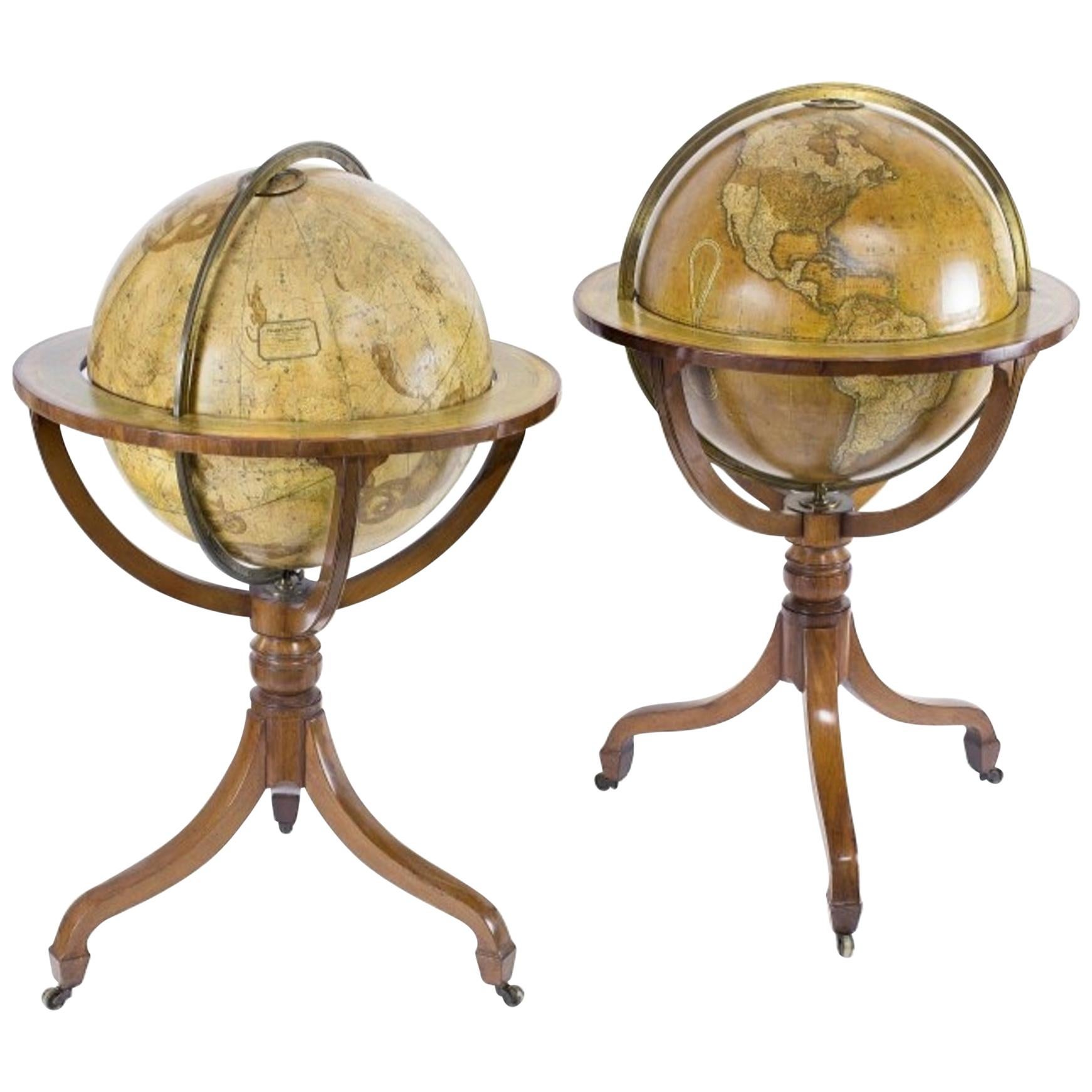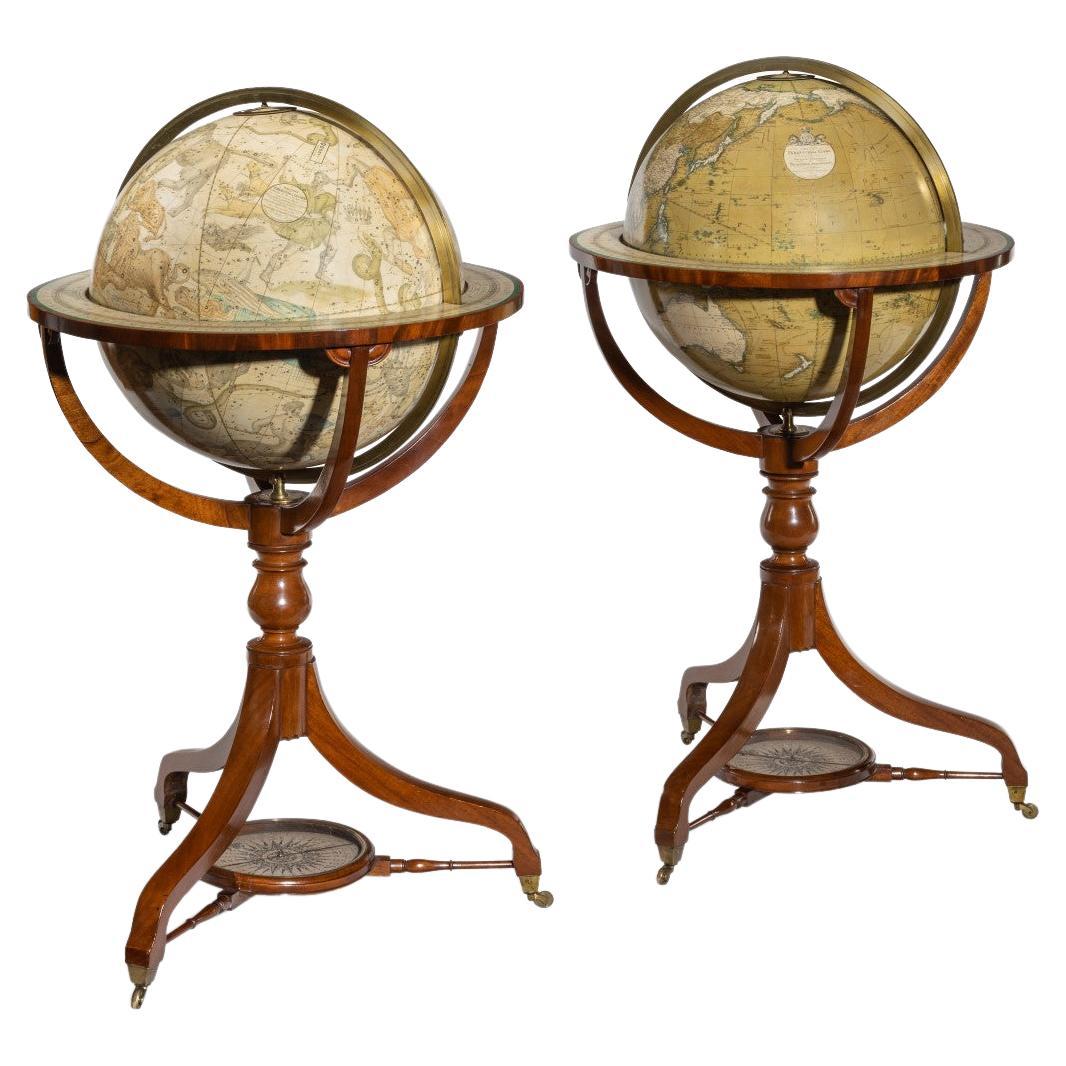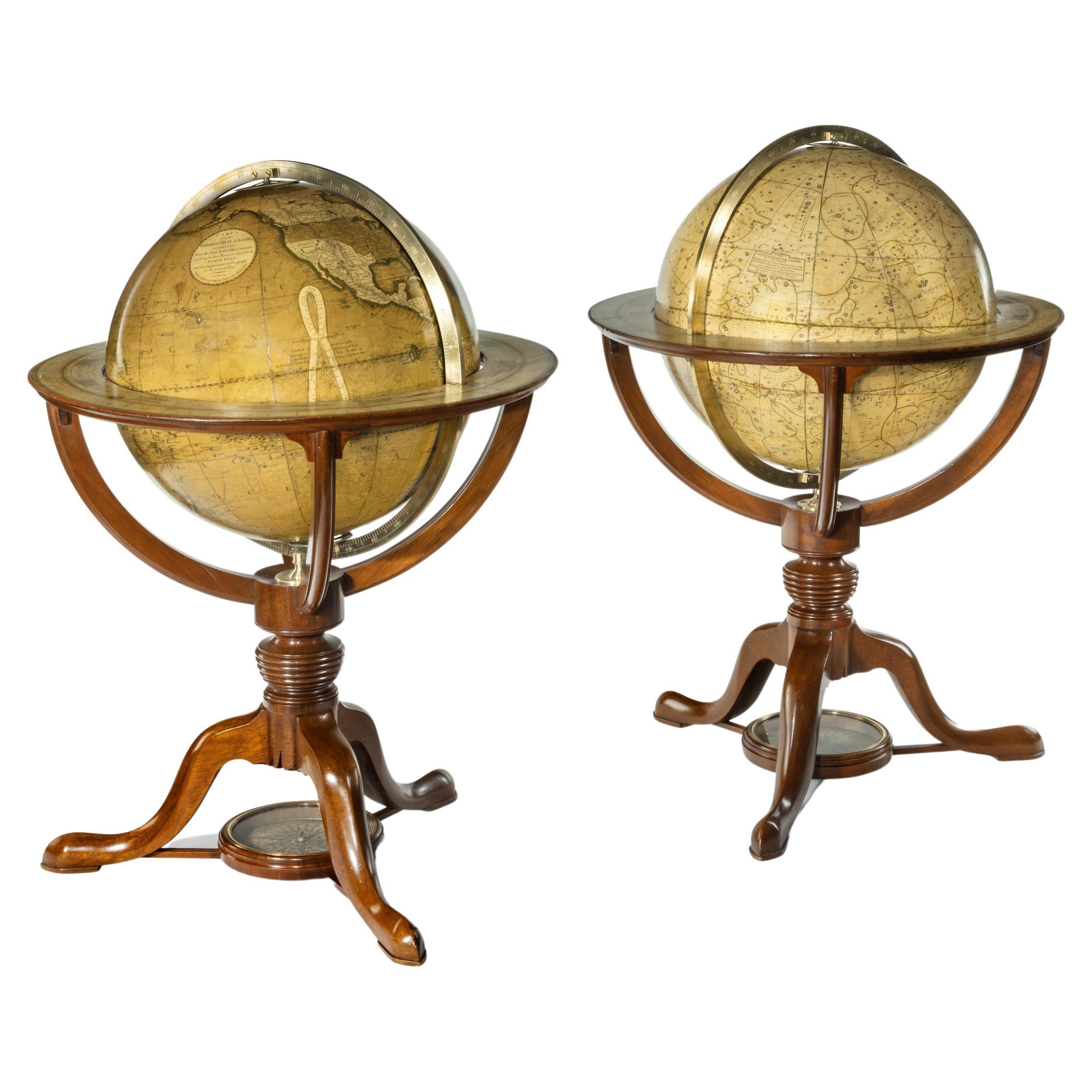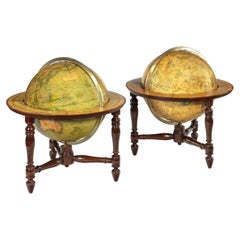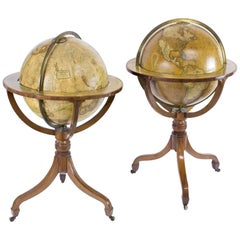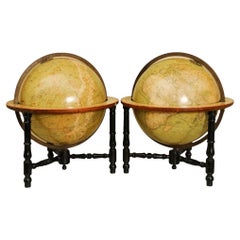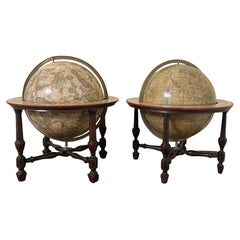Items Similar to A pair of Newton and Son ‘New & Improved’ 15 inch globes
Want more images or videos?
Request additional images or videos from the seller
1 of 12
A pair of Newton and Son ‘New & Improved’ 15 inch globes
$91,901.19per item
£66,750per item
€78,621.47per item
CA$125,900.04per item
A$139,696.71per item
CHF 73,176.14per item
MX$1,713,056.64per item
NOK 930,775.30per item
SEK 878,612.18per item
DKK 586,329.62per item
Quantity
Shipping
Retrieving quote...The 1stDibs Promise:
Authenticity Guarantee,
Money-Back Guarantee,
24-Hour Cancellation
About the Item
Each of these globes is set into a walnut stand with burr walnut veneers to the frieze and a solid turned and gadrooned walnut bluster support. This is raised on three acanthus carved C-curve legs centred on compass roses (replaced). The sharply carved lion’s paw feet enclose the original brass castors. The terrestrial globe label reads ‘Newton’s new and improved terrestrial globe accurately delineated from the observations of the most esteemed Navigators and Travellers to the Present Time, manufactured by Newton and Son. No. 66, Chancery Lane – 3 Fleet Street, Temple Bar, London, Published Febry Ist 1864’. The celestial globe label reads: ‘Newton’s New and Improved Celestial Globe on which all the Stars are taken from the elaborate and most approved Catalogue of Piazzi, the Nebulas from Bode and the double stars and those with proper motions from South. The Right Ascensions & Declinations of the whole having been recalculated and accurately laid down for the year 1851. By Mr. W. Newton. Manufactured by Newton & Son, Chancery Lane, London, Published, Ist March, 1860. The horizon rings are also signed ‘Newton & Son No. 66, Chancery Lane and 3 Fleet Street, Temple Bar, London’. English, dated 1860 and 1864.
Provenance: Alexander Scrimgeour, Highgate and subsequently Wispers House
Ruth Scrimgeour, and thence by descent.
In the 1860s these globes were owned by Alexander Scrimgeour, a stockbroker, who lived with his seven children lived at Woodside, Highgate. He bought the Stedham Estate in 1875 and had Wispers House built in the mock Tudor style, as his main residence, by Richard Norman Shaw. Woolhouse Farm on the estate lay directly below Wispers and in 1897, Mr Scrimgeour gifted this to his daughter Ruth, with the globes and other antiques. Ruth Scrimgeour kept a schoolroom in her farm until the 1930s, and established a pony and horse-breeding establishment and children’s riding school on her marshland on Selsey Bill.
The Newton family are ranked among the leading English globe makers. John Newton (1759-1844) trained under Thomas Bateman before founding his own company in 1780. In the early 1800s John, and his second son William (1786-1861), relocated to 97 Chancery Lane and traded under the name J & W Newton. From 1831 to 1841 another partner was added, civil engineer Miles Berry, and the company became Newton, Son and Berry. After 1841 ownership passed to the eldest son William Edward Newton (1818-1879). It was customary to update globes with the latest discoveries and stars by applying new papers as soon as they were published, hence the varying dates on these globes.
About the Seller
5.0
Recognized Seller
These prestigious sellers are industry leaders and represent the highest echelon for item quality and design.
Established in 1982
1stDibs seller since 2013
130 sales on 1stDibs
Typical response time: 4 hours
Associations
LAPADA - The Association of Arts & Antiques Dealers
- ShippingRetrieving quote...Shipping from: Lymington, United Kingdom
- Return Policy
Authenticity Guarantee
In the unlikely event there’s an issue with an item’s authenticity, contact us within 1 year for a full refund. DetailsMoney-Back Guarantee
If your item is not as described, is damaged in transit, or does not arrive, contact us within 7 days for a full refund. Details24-Hour Cancellation
You have a 24-hour grace period in which to reconsider your purchase, with no questions asked.Vetted Professional Sellers
Our world-class sellers must adhere to strict standards for service and quality, maintaining the integrity of our listings.Price-Match Guarantee
If you find that a seller listed the same item for a lower price elsewhere, we’ll match it.Trusted Global Delivery
Our best-in-class carrier network provides specialized shipping options worldwide, including custom delivery.More From This Seller
View AllPair of 18 Inch Floor Standing Globes by C Smith & Son
Located in Lymington, Hampshire
A pair of 18 inch floor standing globes by C Smith & Son, each set into a mahogany stand with a turned baluster support and three legs centred on a compass, on...
Category
Antique 1840s English Globes
Materials
Mahogany
Pair of Table Globes by G & J Cary, Dated 1800 and 1821
By George & John Cary
Located in Lymington, Hampshire
A pair of 12 inch table globes by G & J Cary, dated 1800 and 1821, each with hand-painted gores, set in mahogany stands with a turned support raised on t...
Category
Antique Early 19th Century English Globes
Materials
Mahogany
Pair of Table Globes by J & W Newton, Dated 1820
By John & William Newton
Located in Lymington, Hampshire
A pair of 12 inch table globes by J & W Newton, dated 1820, each with 12 hand coloured gores, graduated meridian rings, set within ebonised stands with t...
Category
Antique 1820s English Regency Globes
Materials
Wood
Pair of Cary’s Table Globes
Located in Lymington, Hampshire
A pair of Cary’s 15-inch table globes, each set into an ebony stand with four turned legs and stretchers, the terrestrial stating “Cary’s New Terrestrial Globe exhibiting the tracks ...
Category
Antique Early 1800s English Globes
Materials
Ebony
$29,945
A Fine Pair of Cary Globes, Retailed by Kirk and Mercein of New York c.1816-1820
By John Cary
Located in Lymington, Hampshire
Of American Interest-A Fine Pair of Cary Globes, Retailed by Kirk and Mercein of New York c.1816-1820
The globes of celestial and terrestrial form with their original Cary of Lond...
Category
Antique Early 19th Century English Globes
Materials
Wood
Rare Pair of Table Globes by Cary, Each Dated 1816
By John & William Cary
Located in Lymington, Hampshire
A rare pair of 9 inch table globes by Cary, each dated 1816. These globes are by John and William Cary and show the geographical and political borders drawn up following the Congress of Vienna. Each one is surmounted by a brass hour circle, within a calibrated full brass meridian, and a horizon band with an engraved paper calendar...
Category
Antique 1810s English Globes
Materials
Brass
You May Also Like
Newton & Sons Late George III Terrestrial and Celestial Mahogany Library Globes
By Newton and Son
Located in West Palm Beach, FL
Fine pair of Newton & Sons late George III 20 inch terrestrial and celestial tripod mahogany library globes, London, second quarter of the 19th century,
the terrestrial globe, dated...
Category
Antique 1830s Globes
Materials
Wood
Rare and Large Pair of Malby Globes in Fine Original Condition
Located in Lincolnshire, GB
The largest pair of 19th century table globes we have had , at 18' diameter for the globes this pair has ebonised stands. Good original lacquer and colour to the papers. Good makers ...
Category
Antique Mid-19th Century Scientific Instruments
Materials
Fruitwood
A Pair of English 9-Inch Terrestrial and Celestial Table Globes by Wm. Bardin
Located in San Francisco, CA
A fine pair of English 9" terrestrial and celestial globes, each with engraved meridian rings, resting in mahogany stands with turned stretchers, both signed by the maker Wm. Bardin ...
Category
Antique Late 18th Century English George III Globes
Materials
Mahogany, Paper
Pair of 32" Terrestrial and Celestial Globes
Located in New Orleans, LA
Pair of Terrestrial and Celestial Globes
G & T London
20th Century
This extraordinary pair of 32-inch terrestrial and celestial globes, crafted by G & T London, pays homage to the m...
Category
20th Century English Scientific Instruments
Materials
Metal
Superb Pair of Delamarche Table Globes
Located in Lincolnshire, GB
A wonderful pair of 19th century table globes by Mansion Delamarche Paris, in superb original condition. The 12" globes in the original lacquered and gilt decorated stands.
Category
Antique 1860s French Globes
$40,615 / set
A huge pair of 21 inches Cruchley Library Globes
By G.F. Cruchley
Located in ZWIJNDRECHT, NL
G.F. Cruchley (UK, 1796-1880)
London ca 1850
A magnificent pair of terrestrial and celestial globes. Equatorial table engraved with the signs of the zodiac and resting on 3 mahogany molded feet held by a compass at the spacer. With graduated brass meridian circles and time clocks. The terrestrial globe is inscribed in a cartouche: Cruchley's new terrestrial globe from the most recent and best authorities. Exhibiting the discoveries in equatorial Africa, north pole. And the new settlements and divisions in Australia, New Zealand, Californa, Texas, &c. London. Sold by Gould and Porter opticians 181 strand WC. The celestial globe is inscribed in a cartouche: Cruchleys new celestial globe on which is accurately laid down the whole of the stars and nebule contained in the astronomical catalogue of the Reverend Mr. Wollaston F.R.S. Also from the authorities Flamstead, De La Caille, Hevellus, Bradley, Herschel, Maskelyne, &c. Ands the limits of each constellation determined by a boundary line. London, published by G.F. Cruchley, map-seller & globe maker, 81 Fleet street.
Signed: CRUCHLEY in London England, circa 1850 H. 125 cm Diam. 53 cm (21 inches) Diam. 25 cm compasses The two spheres are in a perfect state of freshness and are perfectly legible.
The condition of both the globes is very good. There have been some professional repairs to some damaged gores. The Terrestrial globe in good conserved and legible condition, it has areas of rubbing, retouching, and slight discoloration. The Celestial globe is also in good conserved and legible condition with areas of rubbing, retouching and slight discoloration. The gores themselves have been cleaned and revarnished. The splendid mahogany legs and moulded feet are in first class condition. Each globe consists of 12 hand coloured copper engraved gores over a paper-maché hollow core, made up of two hemispheres joined at the equator and covered with a layer of plaster. There are paper horizon rings, made up of a series of concentric circles, displaying the months of the year, the signs of the zodiac and wind directions.
THE TERRESTRIAL GLOBE.
The globe provides much detailed information, and was accurate up to the date of production, which in this case is the mid-19th century. It shows the latest discoveries and developments that had taken place. It displays names and territories that were once familiar to the people of the age, 150 years into the future! In Asia for example, there are places like ‘Little Bucharia’, ‘Little and Greater Tartary’, ‘Russia in Asia.’ Undoubtedly, the continent that has changed more than any other is Africa. So many African countries that we know and recognise now, had different, perhaps more ‘Colonial’ names more than a century and a half ago. There was ‘Nubia’ (Sudan/Egypt), ‘Abbyssinia’ (Ethiopia), ‘Cape Colony’ (South Africa), ‘Dahomey’ (Benin) but to name a few. Australia was a little over 50 years away from its union via ‘Federation’ in 1901. This brought about the Commonwealth of Australia. However, in 1850 they were six separate British selfserving colonies, ruled directly from England.
In North America, both Los Angeles and San Francisco are incorporated as cities into California - as it becomes the 31st U.S. state. Much of mid-western and western USA were known as ‘The Western Territory’ & ‘The Missouri Territory’, Florida was still refered to as ‘East & West Florida’. Canada was split into ‘Canada East’ & ‘Canada West.’ Canada East was primarily (for historical reasons) French-speaking, and Canada West primarily Englishspeaking. Much of Western Canada remained unexplored and undeveloped. In Europe, there was still the ‘Russian Empire’, the ‘Ottoman Empire’, the ‘AustroHungarian Empire’, and the German ‘Prussian Empire.’
THE CELESTIAL GLOBE.
The Celestial Globe displays the stars, the constellations, clusters and nebulae in a beautiful and well thought out manner. Mythical figures and signs of the zodiac are seen. The equinoctial and solistitial colures are graduated in degrees. Although the colour is somewhat muted, it takes nothing away from the overall beauty and the undoubted aesthetic qualities of the globe.
Historically, globes are among the most ancient scientific instruments known to man. They can be dated back over two millennia, and are still manufactured to this day. The earliest tradition of globe making is mainly concerned with celestial globes – man...
Category
Antique 1850s British Victorian Globes
Materials
Other
More Ways To Browse
English Tudor Rose
Horse Antiques Collectables
Used Furniture Newton
Antique Globe Bar
Ring 1869
Lane Brass
Temple Horse
Tudor Carved
William And Son Ring
William Berry
Milor Rings
Antique Celestial Ring
Shaw Furniture Company
Lane Delineator
Richard Norman Shaw
Paul Mccobb Globe
J Forest Globe
Terrestrial Library Globe
